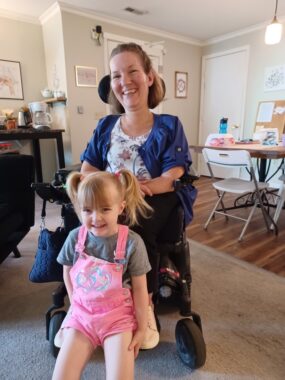How I make wheelchair doughnuts and young friends
When a wheelchair becomes a bit of a playground for children — and me
Written by |

“Connie, can we make some doughnuts?” Two-year-old Eden, with her blond pigtails and soulful blue eyes, asks me this question on a weekly basis.
“Of course, sweet girl,” I reply and let her lead me to the carpet in the open space in my living room. “And how many doughnuts will we make today?”
She thinks seriously about this while she gently slides my feet apart on my footrests, just enough to give her space to sit between them; it’s a seat that seems perfectly designed for her.
“Thirteen,” she decides, and pats the top of my foot as a signal that she’s settled in.
“Thirteen! All right, a baker’s dozen it is, but you have to count it off. Ready?”
You may have figured out by now that Eden and I have a favorite pastime that has little to do with frying rings of dough. The doughnuts we make are circle marks on the carpet left behind by my wheelchair tires when I spin around and around in the same spot.
We make the circuit as many times as Eden wants to, and then we wobble around in a goofy manner because we’re so dizzy. Then I move out of the way so we can admire our freshly spun doughnuts. Eden stands triumphantly in the middle of the circle, and I smile at her with joy and contentment because here, my wheelchair is a key component of this special game we get to play together.
Playtime!

Connie Chandler and Eden Schneider playing their favorite game together. (Courtesy of Connie Chandler)
I live with SMA, and in part, that means that my arms, hands, and legs are very weak. I depend on my power wheelchair to give me mobility and stability throughout the day, and though that allows me to do many wonderful things, I also feel its limits. I cannot play with children the way able-bodied people can: wrestling on the floor, giving piggyback rides, assisting them on a playground, or swooping them up and tossing them in the air. I’m also the absolute worst at hiding in hide-and-seek.
But if I just focus on all the things I can’t do and all the ways I can’t engage with the kids in my life, it would be pretty depressing. It’s a good thing, then, that these kids have great imaginations and that they love me and want to be close to me, because where I see problems, they see possibilities.
Eden isn’t my only little playmate. Some of my young friends like to go for rides on the back of my wheelchair or on my lap. They might pretend I’m a taxi or a train or a ferry … or a very convenient loophole in the game The Floor is Lava!
Some like to race beside me or be chased by me. Some of the more daring and rambunctious of them (boys, naturally) prefer to climb up the sides of my chair like it’s a jungle gym or a rock wall, or a rose lattice to Juliet’s balcony.
Of course, there are dangers when anyone plays around a 400-pound mobile machine. Just like with any other everyday, real-life risk, such as electrical outlets and cleaning chemicals, we teach healthy boundaries and self-control. They all learn early on that, though the lights, buttons, and video-game-type control box on my chair may be tempting, they are only for Connie to touch. In my experience, kids are pretty smart though, and once they understand the rules, they figure out how to have fun and be safe, too.
The more I let children play with me and my wheelchair, the more I find that they aren’t afraid or bothered by it. Every once in a while, they might ask me a question about it, but for the most part they accept it as a natural part of who I am, like glasses or freckles.
And as I watch them grow, I feel a deep sense of hope that their experiences with me will make it easier for them to be kind, compassionate, and creative with other disabled people they encounter. I hope that they will always find the possibilities in the “problems,” because when they do, they make things like joy and beauty and doughnuts. They make the world a better place.
Note: SMA News Today is strictly a news and information website about the disease. It does not provide medical advice, diagnosis, or treatment. This content is not intended to be a substitute for professional medical advice, diagnosis, or treatment. Always seek the advice of your physician or other qualified health provider with any questions you may have regarding a medical condition. Never disregard professional medical advice or delay in seeking it because of something you have read on this website. The opinions expressed in this column are not those of SMA News Today or its parent company, Bionews, and are intended to spark discussion about issues pertaining to spinal muscular atrophy.







Leave a comment
Fill in the required fields to post. Your email address will not be published.